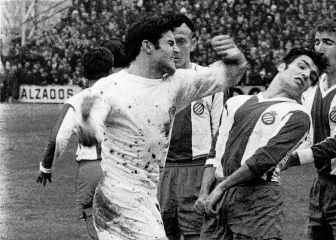“Sarriá, powder magazine of emotions”, read the cover of El Mundo Deportivo de Barcelona on Sunday, January 5, 1969. The title was accompanied by photos of Amancio and Marcial, figures from Madrid and Espanyol, who had to face each other in the old Sarria.
The second round began. Madrid was the undefeated leader and Español was doing poorly, despite their luxurious striker from Los Delfines (Amas, Marcial, Re, Rodilla and José María) the most talked about of a team with other figures such as Lico or Glaría. Created by the bold and controversial Vila Reyes to challenge for the title, he had lost all seven of his starts and two home games.
It was played in the morning because it was Epiphany. It rained the whole night before, it was still raining at game time. Madrid (ye-yé) suffered a loss, Pirri, who was replaced by José Luis, more than a substitute: an excellent player whose ideal position was fatally Pirri’s and for that reason he had to seek life in others. He was international as a winger and as a winger. He had a rare knack for scoring, which is why Tony Leblanc baptized him as Pepe El Goles in the AS newspaper.
Espanyol started briskly and crashed a ball into Betancort’s squad. But Madrid soon took control thanks to the enormous play of their midfielder, José Luis-Grosso-Velázquez. Amancio scored before the break.
In minute 56, Miguel Pérez, who was being hounded by Riera and José María, turned on him and punched him that the referee Medina Iglesias did not notice. José María falls, the usual whirlpool sets in, he gets up.
In the hubbub of discussions, he kicks José Luis in the Achilles tendon and now it is the Real Madrid player who falls to the ground. Medina expels José María between a great anger. José Luis gets up, is talking to Marcial when Riera approaches, insults are exchanged, he hits him in the stomach and José Luis unleashes an impeccable one-two. Now the expelled is José Luis.
The scene is captured by one of the two Pérez de Rozas brothers (legendary surname in Barcelona journalism for three generations), Carlos or Enrique, who covered the match for the Cifra agency, under whose signature it was published. It looks like a boxing scene. It was the cover of all the sports, opened the sports section of the general newspapers, occupied generous space on the television news and was widely disseminated in the foreign press.
The Committee ruled on Wednesday: four matches against José Luis, another as many against José María for assault, two against Riera for being violent with an opponent and another two against Miguel Pérez for attempted assault. Medina Iglesias is suspended for a month and loses his rights for that party due to omissions in the minutes and lack of authority.
José Luis remembers that in detail with a distant regret: “I left my team with ten, we were winning and we ended up tied. Miguel Muñoz scolded me, he told me, didn’t you see that they were provoking him? And also with a certain humor: “They called me Pepe Goles, my colleagues started calling me Pepe KO The photo was great, I think they gave the photographer a prize of half a million or something like that.”
What caught the most attention was the technical correction of José Luis’s hitting and Riera’s dodge. Pedro Carrasco, the very champion of the time, commented in an interview that he seemed like real boxing. “Many newspapers came to me from abroad. One said in English that in the fields of Spain, in addition to soccer, boxing was practiced. I have clippings lying around. It’s not something I’m proud of, but it happened. Between Riera and me he left no embers, we both know that these things happen in football”.
It was the most famous punch in Spanish football.
